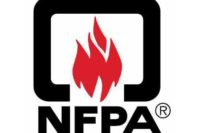Reinventing fire detection in industrial warehouses Advanced fire detection technology detects smoke at the earliest possible stage, while reducing false alarms and maintenance in large industrial warehouses
The cost of a fire in a warehouse goes far beyond the loss of the building and goods. The consequential loss caused by downtime, operation interruption, business reputation and goodwill can be significant.
Modern goods also tend to have increased flammability, in addition to the presence of large amounts of packing materials such as plastics, cardboard, wooden crates and pallets. There are various possible ignition sources in warehouses including smoking, lighting, electrical equipment and heaters. Although sprinklers are typically installed in warehouses, the lack of an appropriate early warning smoke detection system can not only compromise the safety of the facility but also that of adjacent buildings.
Fortunately, protecting life and inventory is much easier for even the largest warehouses as aspirating smoke detection (ASD) technology becomes more widely adopted. The process draws in air samples through durable piping to detectors and tests it using sophisticated laser-based technology, imaging, and photodiodes. Far from new, the core technology has been used for decades in sensitive applications such as cleanrooms and data centers where early smoke detection is critical.
Compared to traditional spot smoke detectors and other technologies, this approach dramatically improves warehouse facility safety by detecting smoke at the earliest possible stage via numerous sampling points, while reducing false alarms and maintenance.
Industrial-Sized Smoke Detection Challenges
Warehouses come in a wide range of sizes and contain a wider range of goods. Most large warehouses have high ceilings of over 40 ft. (12 m), with some modern automated high rack storage facilities having ceiling heights over 130 ft. (40 m).
The problem is that in these conditions any smoke is heavily diluted. This makes detection difficult for conventional detection technologies where smoke must build up to certain levels before the alarm sounds. Furthermore, before sprinklers are triggered, sufficient heat needs to be generated by the fire – by which time, it is well underway.
Because of these concerns, traditional spot smoke detectors are usually considered unsuitable for warehouses with high ceilings. The installation, wiring, testing, and maintenance of such spot detectors make them inconvenient and costly.
For instance, regularly testing the smoke detectors requires having an inspector introduce smoke into the devices. This requires safely lifting the inspector to the level of the detector on a scissor lift, cherry picker, or other access equipment, which adds to inspection costs. Maintaining and repairing the smoke detectors is similarly costly.
The situation is even more challenging in facilities that operate 24/7, where maintenance is only allowed during a planned maintenance period.
Linear heat cables and flame detectors are sometimes suggested offered as a solution and might be tempting from a maintenance point of view. However, their detection point (i.e. the flaming stage of fire) is too late to be truly considered as early warning or adequate detection.
Optimizing Warehouse Smoke Detection
Instead, as an alternative, ASD technology is a more effective, early detection option that does not require physical maintenance to access warehouse ceiling areas above high bay racks.
Because of such flexibility, ASD smoke detection accommodates irregular ceiling structures. Moreover, the technology is not affected by forklifts, robotic gantries, and internal business operations. Finally, it can even provide detection within storage racks for the fastest possible response to a fire threat.
As an example, one system, called VESDA-E VEU, by Xtralis, a global provider of aspirating fire detection equipment, draws air samples in a continuous process through holes in long runs of durable industrial pipe mounted along the walls and ceiling.
While some ASD products use an LED light source and one or more photo receivers, the VEU utilizes a flair detection chamber that uses a short wavelength laser, a CMOS imager, and multiple photodiodes.
Direct imaging of the sampled particles using the CMOS camera allows data regarding its size, color and shape to be derived. Additional data from five photodiodes allows measurement of light scatter in different directions.
With more detailed information to analyze, the unit is able to differentiate smoke from other factors that could cause disruptive false alarms. For warehouse environments where airborne dust particles may also be present, which can be confused as smoke by some systems, the unit’s dust rejection and data analytics minimize nuisance alarms by at least 3 times compared to similar technologies.
Compared to even other aspirating technologies, the system significantly saves on maintenance costs by allowing long pipe runs up to 1,310 ft. (400 m) and branched pipe networks up to 2,625 ft. (800 m) to extend detector coverage. This reduces the number of detectors required to protect a single fire zone in a warehouse facility.
Unique Warehouse Challenges
Certain types of warehouses in difficult environments may still require a high level of fire protection, while posing unique challenges to smoke detection systems.
Freezers & Refrigerated Storage
While most warehouses with freezers or refrigerated storage have some form of automatic doors or plastic barrier curtains to limit warm air ingress, it is inevitable that warm air will enter the room. This often creates condensation within the room, which causes icing on ceiling-mounted equipment and structures close to the entry points.
Even though ASD technology is generally accepted as the best solution for refrigerated storage facilities, there are some typical problems associated with its application in such situations.
Over time, ASD sampling points and pipe within the sub-zero area can become blocked causing air flow issues and inoperative detection of smoke. In some instances, the only solution is to remove the iced up section of the ASD pipe network and fit a new pipe.
To combat this issue, some providers offer a unique sampling arrangement that is specifically designed for refrigerated storage facilities.
For example, Xtralis enables ASD air sampling pipe to be installed, inspected and maintained outside the refrigerated environment (i.e. within roof space). This makes it less prone to blockage due to icing, easier to inspect, and provides a more robust, longer lasting installation.
Dusty Warehouses
Certain warehouses are very dusty or highly contaminated environments such that the performance, longevity and maintenance of the detection equipment are a real concern.
For these environments, ASD systems exist that are design to withstand the harsh environments in industrial applications, have superior dust filtration and are enclosed in NEMA 4 equivalent enclosures.
The Xtralis’ VESDA VLI system, for example, comes in an International Protection Marking IP66 enclosure that provides total protection against the ingress of dust and strong water jets. The unit also is designed with a patented intelligent filter that significantly reduces the amount of contaminants entering the detector. An integral secondary filter and sub-sampling probe also rejects larger dust particles, which further safeguards against nuisance alarms and extends detector life.
Protecting the Warehouse Bottom Line
Some managers of warehouse facilities may be inclined to use spot smoke detectors or other traditional devices because of their familiarity with such systems.
However, those who take advantage of the superior capabilities of ASD systems will protect lives and inventory to a degree not previously possible in warehouse settings. This level of protection will also prevent serious supply chain disruption as well as liability and litigation in worst case scenarios.
For more information, contact Xtralis at 175 Bodwell Street, Avon, MA 02322, call: +1 (619) 252-2015; email: rsandler@xtralis.com or visit: www.xtralis.com/vea.






